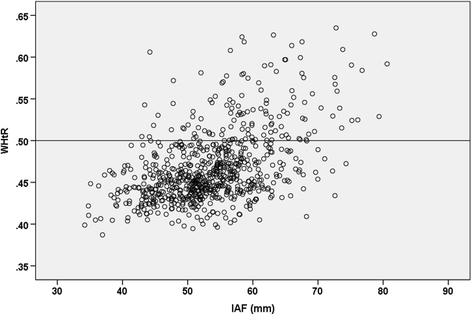Cardio-metabolic and socio-environmental correlates of waist-to-height ratio in German primary schoolchildren: a cross-sectional exploration
- PMID: 29475449
- PMCID: PMC5824571
- DOI: 10.1186/s12889-018-5174-6
Cardio-metabolic and socio-environmental correlates of waist-to-height ratio in German primary schoolchildren: a cross-sectional exploration
Abstract
Background: Controversial messages of childhood obesity emerge: Levelling off in terms of body mass index (BMI) is foiled by increases in abdominal obesity. Waist-to-height ratio (WHtR) may be used as a screening tool for abdominal obesity in children. The aim of this study was to investigate clinical and socio-environmental correlates of abdominal obesity in primary schoolchildren.
Methods: Cross-sectional data from 753 children participating in baseline assessments of the outcome evaluation of a school-based prevention program were analysed. Abdominal obesity was defined as WHtR ≥0.5. According to German age and sex-specific BMI-percentiles, overweight (>90th percentile) and obesity (>97th percentile) were determined. Anthropometric and sonographic measurements, blood pressure and blood samples were taken by clinical staff in a standardized manner. Socio-environmental and lifestyle data were assessed via parental questionnaires. Differences between abdominally obese children and others, and correlations of WHtR with clinical data were tested. Socio-environmental correlates of abdominal obesity were explored in a logistic regression analysis.
Results: At the time of the examination children were 7.57 ± 0.42 years old. Abdominal obesity was observed in 132 (17.5%) children. According to BMI-percentiles, 22.9% of these children were obese, 38.2% overweight, and 38.2% normal weight. Affected children more often used screen media and less often participated in club sports. Abdominal obesity was associated with higher blood pressure, lower HDL- and higher LDL-cholesterol. WHtR significantly correlated with intra-abdominal fat thickness (IAF). The logistic regression model revealed migration background (odds ratio (OR) 2.12, 95% confidence interval (CI) [1.41, 3.19]), smoking during pregnancy (OR 2.30, 95% CI [1.37, 3.86]), parental obesity (OR 1.95, 95% CI [1.22, 3.10]) and higher educational level (OR 0.64, 95% CI [0.42, 0.98]) to be significantly associated with abdominal obesity in children.
Conclusion: WHtR correlates strongly with IAF. Abdominal obesity in primary schoolchildren is associated with cardio-metabolic risk factors and also occurs in otherwise normal weight children. Against the background of rising numbers of abdominal obesity in children, targeted preventive measures are long overdue. The focus of such measures should be used on children with migration background and involve parents, especially those who are obese and those with lower educational levels.
Keywords: (MeSH); Abdominal obesity; Blood pressure; Child; Etiology; Lipids; Prevention & control.
Conflict of interest statement
Ethics approval and consent to participate
The study protocol was approved by the ethics committee of Ulm University in 2006. Written informed consent was obtained from parents and teachers.
Consent for publication
Not applicable
Competing interests
The authors declare that they have no competing interests.
Publisher’s Note
Springer Nature remains neutral with regard to jurisdictional claims in published maps and institutional affiliations.
Figures


Similar articles
-
Utility of waist-to-height ratio in assessing the status of central obesity and related cardiometabolic risk profile among normal weight and overweight/obese children: the Bogalusa Heart Study.BMC Pediatr. 2010 Oct 11;10:73. doi: 10.1186/1471-2431-10-73. BMC Pediatr. 2010. PMID: 20937123 Free PMC article.
-
Utility of waist circumference-to-height ratio as a screening tool for generalized and central obesity among Iranian children and adolescents: The CASPIAN-V study.Pediatr Diabetes. 2019 Aug;20(5):530-537. doi: 10.1111/pedi.12855. Epub 2019 May 16. Pediatr Diabetes. 2019. PMID: 30968521
-
Tri-Ponderal Mass Index vs body Mass Index in discriminating central obesity and hypertension in adolescents with overweight.Nutr Metab Cardiovasc Dis. 2021 May 6;31(5):1613-1621. doi: 10.1016/j.numecd.2021.02.013. Epub 2021 Feb 23. Nutr Metab Cardiovasc Dis. 2021. PMID: 33741212
-
Offspring body size and metabolic profile - effects of lifestyle intervention in obese pregnant women.Dan Med J. 2014 Jul;61(7):B4893. Dan Med J. 2014. PMID: 25123127 Review.
-
Determinants of central obesity in children and adolescents and associated complications in South Africa: a systematic review.Front Public Health. 2024 Apr 23;12:1324855. doi: 10.3389/fpubh.2024.1324855. eCollection 2024. Front Public Health. 2024. PMID: 38716247 Free PMC article.
Cited by
-
Birth and Health Outcomes of Children Migrating With Parents: A Systematic Review and Meta-Analysis.Front Pediatr. 2022 Jul 13;10:810150. doi: 10.3389/fped.2022.810150. eCollection 2022. Front Pediatr. 2022. PMID: 35911841 Free PMC article.
-
Long-acting antiretroviral therapy in low-income and middle-income countries: considerations for roll-out.Curr Opin HIV AIDS. 2025 Jan 1;20(1):19-24. doi: 10.1097/COH.0000000000000900. Epub 2024 Nov 11. Curr Opin HIV AIDS. 2025. PMID: 39561043 Free PMC article. Review.
-
Combined Body Mass Index and Waist-to-Height Ratio and Its Association with Lifestyle and Health Factors among Spanish Children: The PASOS Study.Nutrients. 2022 Jan 6;14(2):234. doi: 10.3390/nu14020234. Nutrients. 2022. PMID: 35057414 Free PMC article.
-
Percentile Reference Values for the Neck Circumference of Mexican Children.Children (Basel). 2021 May 18;8(5):407. doi: 10.3390/children8050407. Children (Basel). 2021. PMID: 34069920 Free PMC article.
-
Effectiveness of a multi-faceted intervention among elementary school children.Medicine (Baltimore). 2019 Apr;98(15):e15079. doi: 10.1097/MD.0000000000015079. Medicine (Baltimore). 2019. PMID: 30985659 Free PMC article.
References
-
- Garnett SP, Baur L a., Cowell CT. The prevalence of increased central adiposity in Australian school children 1985 to 2007. Obes Rev 2011;12(15):887–896. - PubMed
-
- Javed A, Jumean M, Murad MH, et al. Diagnostic performance of body mass index to identify obesity as defined by body adiposity in children and adolescents: a systematic review and meta-analysis. Pediatr Obes. 2014:1–11. - PubMed
Publication types
MeSH terms
Substances
LinkOut - more resources
Full Text Sources
Other Literature Sources
Medical

